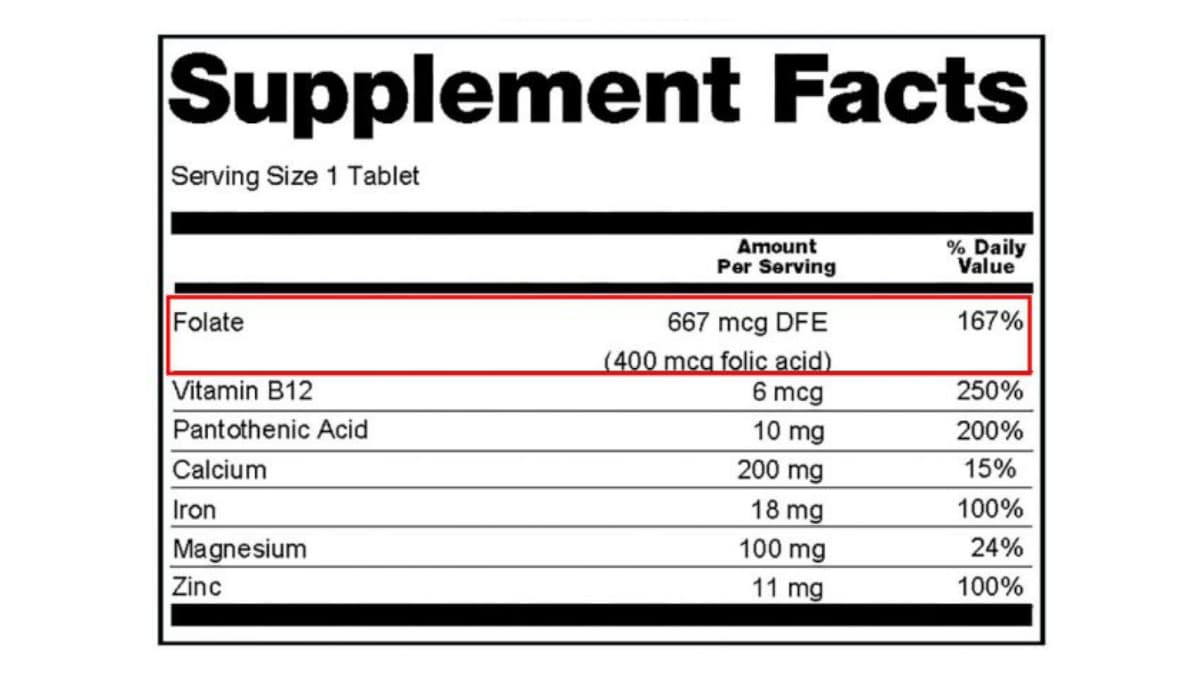Key points
- Folic acid is the only form of folate (vitamin B9) shown to help prevent neural tube defects.
- All people capable of becoming pregnant should get 400 micrograms of folic acid daily.
- It's important to educate patients about folic acid, its benefits, and its sources.

Overview
Folic acid is a form of folate, which is a B vitamin. It is essential for cell growth and development. The terms "folate" and "folic acid" are often used interchangeably. However, folate is a general term used to describe many different forms of vitamin B9. This includes folates occurring naturally in foods, like leafy greens, and forms that are man-made, like folic acid.
Folic acid is more stable than folates found naturally in food. It is used in supplements and fortified foods, such as bread, pasta, some breakfast cereals, and some corn masa flour.
A woman needs adequate folate in early pregnancy to properly form the neural tube, which becomes a baby's brain and spine. Folic acid plays a particularly important role early in pregnancy. Many studies have shown that taking folic acid before and during pregnancy can help lower the chance of neural tube defects.1 Getting 400 micrograms (mcg) of folic acid daily can help prevent neural tube defects (NTDs).
Prevention
General recommendation
CDC recommends that all people capable of becoming pregnant get 400 mcg of folic acid daily. This recommendation is supported by the Institute of Medicine and US Preventive Services Task Force.
It can be difficult for most people to get the recommended daily amount through natural food folates, like leafy greens. In addition to eating foods with folate from a varied diet, folic acid can be obtained through:
- Dietary supplements. A daily multivitamin containing 400 mcg of folic acid.
- Fortified foods. Folic acid is added to foods like some breakfast cereals and corn masa flour. These products are labeled as "enriched."
- A combination of the two. Eating fortified foods and taking a daily multivitamin.
Recurrence prevention
Individuals who previously had a pregnancy affected by an NTD face higher risks of having another pregnancy affected by an NTD. For those who are planning another pregnancy, it is recommended they get 4,000 mcg of folic acid daily. This should start one month before conception and through the first 3 months of pregnancy.
If not planning a pregnancy, the general recommendation of 400 mcg of folic acid daily applies.
Patient counseling
As a healthcare provider, you play an important role in educating patients about the benefits of folic acid. Below are some key considerations for counseling.
- Begin conversations before pregnancy about folic acid and its benefits. Encourage all people capable of becoming pregnant to get 400 mcg of folic acid daily. Patients planning to become pregnant and not currently taking folic acid should start taking folic acid at least 1 month before conception and continue during pregnancy. Waiting until the first prenatal visit to start folic acid consumption will not prevent NTDs.
- Share information on the different sources of folic acid, such as multivitamins and fortified foods. Explain how patients can get the recommended amount of folic acid daily by including fortified foods and/or multivitamins in their diets.
- Encourage patients to check their supplement and fortified food labels to ensure they contain folic acid. Explain how to read Supplement and Nutrition fact labels or show them what to look for.
MTHFR gene variants
The MTHFR gene provides instructions for an enzyme that helps process folate in the body.2 After testing with a direct-to-consumer genetic testing kit, patients may be seeking guidance on taking folic acid given their MTHFR genotype.
The most common variant in the MTHFR gene is MTHFR C677T.3This variant involves a change at position 677 in the MTHFR gene, which can result in the following genotypes:
- MTHFR 677 CC
- MTHFR 677 CT
- MTHFR 677 TT
With similar folate intake, people with the MTHFR TT genotype have an average amount of folate in their blood that is only slightly lower (about 16% lower) than those with the MTHFR CC genotype.4 However, studies show that getting 400 mcg of folic acid daily can increase blood folate levels, regardless of their MTHFR genotype.5
Folic acid is the only type of folate shown to help prevent NTDs.26478
There are no clinical recommendations at this time to test for MTHFR status or for consuming a different amount of folate or folic acid on the basis of the MTHFR genotype.
No matter which MTHFR genotype your patient has, you can assure them that folic acid is safe and essential for people capable of becoming pregnant.
Observed trends
Daily multivitamin use
Daily multivitamin use has declined among women of reproductive age in the United States.9
Specifically, this decline was observed among women aged 25–44 years, as well as among non-Hispanic White and Hispanic women. Among different age groups, women aged 18–24 years reported the lowest daily multivitamin use.
Additionally, a CDC study found that about half of U.S. women report enriched cereal grain products as their only source of folic acid.10
Consuming folic acid from a combination of sources like supplements and fortified foods:
- Helps people get the recommended 400 mcg of folic acid daily; and
- Can prevent up to 700 additional NTDs each year.10
At-risk populations
Research shows that some groups are still not getting enough folic acid to lower their risk of NTDs. Hispanic/Latina women are more likely to have a child born with an NTD than are non-Hispanic White and non-Hispanic Black women.111213
Changes to Nutrition and Supplement Facts labels
Nutrition Facts and Supplement Facts labels have recently undergone changes, including the units of measure for folate. Folate is now shown as "mcg DFE" (micrograms of dietary folate equivalents). The new labels provide information on both the amount of folate in mcg DFE and the amount of folic acid per serving. If folic acid is present in the product, it will be listed in parentheses alongside the total folate content.

To prevent anemia, individuals should get 400 mcg DFE (100% daily value (DV) for folate). This is equal to 240 mcg folic acid. However, it takes more folic acid to help prevent NTDs than to prevent anemia. The recommendation is to get 400 mcg of folic acid to help prevent NTDs. This is equal to 667 mcg DFE (167% DV).
Generally, vitamins contain 400 to 800 mcg of folic acid, but some contain other forms of folate (such as 5-MTHF) instead. Folic acid is the only form of folate shown to help prevent NTDs. No scientific studies exist that show that supplements containing other forms of folate can prevent NTDs. It's important to remind patients to check supplement labels to ensure they contain folic acid.
- Crider, K. S., Qi, Y. P., Yeung, L. F., Mai, C. T., Head Zauche, L., Wang, A., Daniels, K., & Williams, J. L. (2022). Folic acid and the prevention of birth defects: 30 years of opportunity and controversies. Annual Review of Nutrition, 42(1), 423–452.
- Crider KS, Yang TP, Berry RJ, Bailey LB. Folate and DNA methylation: A review of molecular mechanisms and the evidence for folate's role. Adv Nutr. 2012;3(1):21-38.
- Online Mendelian Inheritance in Man, OMIM®. Johns Hopkins University, Baltimore, MD. MIM Number: 236250: 12/11/2014: https://omim.org/entry/236250#genotypePhenotypeCorrelations
- Tsang BL, Devine OJ, Cordero AM, et al. Assessing the association between the methylenetetrahydrofolate reductase (MTHFR) 677C>T polymorphism and blood folate concentrations: a systematic review and meta-analysis of trials and observational studies. Am J Clin Nutr. 2015;101(6):1286-1294.
- Crider KS, Zhu JH, Hao L, Yang QH, Yang TP, Gindler J, Maneval DR, Quinlivan EP, Li Z, Bailey LB, et al. MTHFR 677C->T genotype is associated with folate and homocysteine concentrations in a large, population-based, double-blind trial of folic acid supplementation. Am J Clin Nutr 2011;93(6):1365-72. doi: 10.3945/ajcn.110.004671.
- Wilcken B, Bamforth F, Li Z, et al. Geographical and ethnic variation of the 677C>T allele of 5,10 methylenetetrahydrofolate reductase (MTHFR): Findings from over 7000 newborns from 16 areas world wide. J Med Genet. 2003;40(8):619-625.
- Seyoum E, Selhub J. Properties of food folates determined by stability and susceptibility to intestinal pteroylpolyglutamate hydrolase action. J Nutr. 1998;128(11):1956-1960.
- Crider KS, Devine O, Hao L, et al. Population red blood cell folate concentrations for prevention of neural tube defects: Bayesian model. BMJ. 2014;349:g4554.
- Wong EC, Rose CE, Flores AL, Yeung LF. Trends in multivitamin use among women of reproductive age: United States, 2006–2016. J Women's Health (Larchmt). 2019;28(1):37–45.
- KS, Qi YP, Devine O, Tinker SC, Berry RJ. Modeling the impact of folic acid fortification and supplementation on red blood cell folate concentrations and predicted neural tube defect risk in the United States: Have we reached optimal prevention? Am J Clin Nutr. 2018;107(6):1027–1034.
- Williams J, Mai CT, Mulinare J, et al. Updated estimates of neural tube defects prevented by mandatory folic acid fortification – United States, 1995–2011. MMWR Morb Mortal Wkly Rep. 2015;64(1):1–5.
- Centers for Disease Control and Prevention (CDC). Racial/ethnic differences in the birth prevalence of spina bifida – United States, 1995–2005. MMWR Morb Mortal Wkly Rep. 2009;57(53):1409–1413.
- Canfield MA, Mai CT, Wang Y, et al. The association between race/ethnicity and major birth defects in the United States, 1999–2007. Am J Public Health. 2014;104(9):e14–23.
- Centers for Disease Control and Prevention (CDC). Use of folic acid for prevention of spina bifida and other neural tube defects–1983–1991. MMWR Morb Mortal Wkly Rep. 1991;40(30):513–516.
- Recommendations for the use of folic acid to reduce the number of cases of spina bifida and other neural tube defects. MMWR Recomm Rep. 1992;41(RR-14):1–7.
